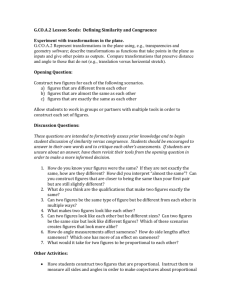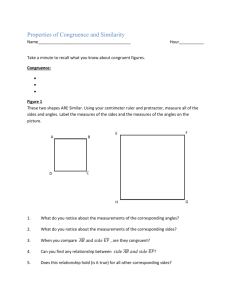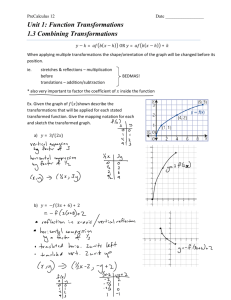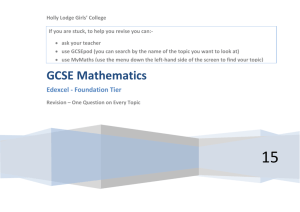File
advertisement
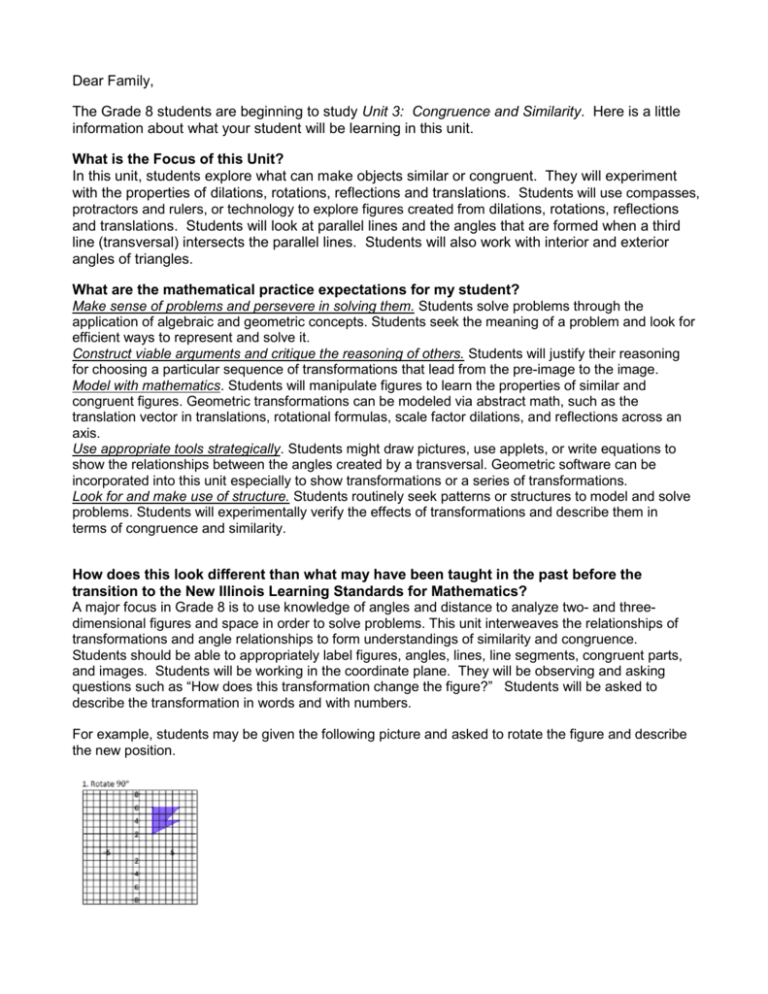
Dear Family, The Grade 8 students are beginning to study Unit 3: Congruence and Similarity. Here is a little information about what your student will be learning in this unit. What is the Focus of this Unit? In this unit, students explore what can make objects similar or congruent. They will experiment with the properties of dilations, rotations, reflections and translations. Students will use compasses, protractors and rulers, or technology to explore figures created from dilations, rotations, reflections and translations. Students will look at parallel lines and the angles that are formed when a third line (transversal) intersects the parallel lines. Students will also work with interior and exterior angles of triangles. What are the mathematical practice expectations for my student? Make sense of problems and persevere in solving them. Students solve problems through the application of algebraic and geometric concepts. Students seek the meaning of a problem and look for efficient ways to represent and solve it. Construct viable arguments and critique the reasoning of others. Students will justify their reasoning for choosing a particular sequence of transformations that lead from the pre-image to the image. Model with mathematics. Students will manipulate figures to learn the properties of similar and congruent figures. Geometric transformations can be modeled via abstract math, such as the translation vector in translations, rotational formulas, scale factor dilations, and reflections across an axis. Use appropriate tools strategically. Students might draw pictures, use applets, or write equations to show the relationships between the angles created by a transversal. Geometric software can be incorporated into this unit especially to show transformations or a series of transformations. Look for and make use of structure. Students routinely seek patterns or structures to model and solve problems. Students will experimentally verify the effects of transformations and describe them in terms of congruence and similarity. How does this look different than what may have been taught in the past before the transition to the New Illinois Learning Standards for Mathematics? A major focus in Grade 8 is to use knowledge of angles and distance to analyze two- and threedimensional figures and space in order to solve problems. This unit interweaves the relationships of transformations and angle relationships to form understandings of similarity and congruence. Students should be able to appropriately label figures, angles, lines, line segments, congruent parts, and images. Students will be working in the coordinate plane. They will be observing and asking questions such as “How does this transformation change the figure?” Students will be asked to describe the transformation in words and with numbers. For example, students may be given the following picture and asked to rotate the figure and describe the new position. How will my student apply what he/she learns in the future? In the next unit, Functions, students will formalize their understanding of functions and can use transformations as a model. At the high school level, students will apply transformations to numbers, functional representations and data. How can you help your student at home? One of the best things you can do during this unit is to ask your child to define the vocabulary terms from this unit. Make flashcards with your child and use them to review the vocab. Ask your child about the tasks that they are working on during math class. What are vocabulary terms that will be addressed? Transformations - A change in the position, size or shape of a figure. The most common transformations include translation, rotation, reflection and enlargement. Pre-Image - The original figure before the figure is transformed. Image - The result produced by a transformation or a mapping. For example, when a figure is transformed into another by reflection in a line, the reflected figure is called the image. Translations - The action of moving a figure along a line for a given distance. Rotations - Turning of a figure around a fixed point, as a wheel turns on its axis. Center of Rotation - The fixed point around which a two-dimensional figure is rotated. Angle of Rotation - The measure of degrees that a figure is rotated about a fixed point. Reflection - Also called flip. It is the mirror image of a figure. Line of Reflection - The line where you could fold the image and have both halves match exactly Dilation - A transformation that enlarges or reduces a figure. Center of Dilation - The center of dilation is a fixed point in the plane about which all points are expanded or contracted. Transversal - A line that intersects two or more lines. Exterior Angles - An angle formed on the outside of a polygon by extending one of its sides. Interior Angles - One of the angles inside a polygon or one of the internal angles formed when two or more lines are intersected by a transversal. Student Self-Assessment Grade 8 Unit 3: Congruence and Similarity 0 - I haven’t tried. 1 - I cannot do this yet. 2 - I can do this with some help from my teacher or peers. 3 - I can sometimes do this on my own. 4 - I can do this on my own. Target: I can describe a series of transformations that exhibits congruence between two congruent figures. I can describe transformations (dilations, translations, rotations, and reflections) with words and coordinates. I can describe a series of transformations that exhibits similarity between two similar figures. I can find the measures of angles using transversals, the sum of angles in a triangle, the exterior angles of triangles. I can determine if triangles are similar using angle-angle criterion I can justify congruence or similarity of figures using a series of transformations. Date Initials


